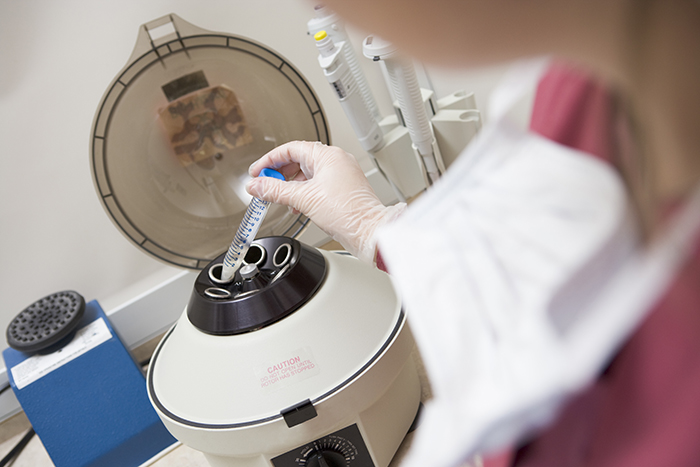Have you ever wondered what it would be like to be in the shoes of a phlebotomy technician for one day? If you have ever considered becoming a phlebotomy technician you may want to read the following and take a peak at what a phlebotomist does during their shift.
Clocking in at 7am
As a phlebotomy technician you have clocked in for your shift and proceed to the laboratory where your supervisor will provide you with a print out of patients who need blood draws. Upon looking at the list you see several, “Stat” draws for electrolytes and blood cultures. The next thing you do is to wash your hands, put on your lab coat and gathering your supplies for your phlebotomy tray.
Going to your Floor at 7:20 am
Now you are on the floor. You have priority stat draws which you must draw first. You knock on the the patient’s door and wait to be acknowledged. Upon doing so, you ask the patient for their permission to draw their blood. Upon choosing the proper vacutainer tubes and using the appropriate needle gauge, you proceed to draw their blood. Because both lab draws are stat, they must be taken back down to the lab immediately. Upon going to the elevator you notice that there are quite a few visitors and physicians waiting. Realizing that you must deliver the specimens immediately you proceed to take the stairs down to the lab. There are 10 flights of stairs that you must cover to get to the lab.
Upon dropping off the stat lab specimens, you must now get back to the floor and resume the rest of your blood draws which are considered routine and can be done during the entire shift. However, you must now climb 10 flights of stairs because all the elevators are busy.
Finishing up your Routine draws at 8:20 am
As you go from room to room and floor to floor to obtain patients laboratory specimens you notice that one of your patients are refusing to have their blood drawn. They have called you many names, although they have never met you and demanded that you leave their room at once. Nervous and shaken you leave the room and explain to the patient’s nurse what had transpired. The nurse tells you that this patient has an organic brain disease and that if you are willing to wait, she will go and speak with them. In the meantime you have had to call you laboratory supervisor and explain that you were unable to obtain a blood draw from you assigned patient. Needless to say, your laboratory supervisor does not understand and is not happy. After the nurse calmed the patient down, she remained with the patient until you were able to obtain the blood draw.
You next patient had IV lines in both arms. Knowing that your scope of practice does not allow you to draw from peripherally inserted catheters you must get the nurse to turn off each of the IV’s for a minimum of 20 minutes before you are able to draw from a vein below the IV site which is currently in the antecubital fossa, or the bend in the arm anterior to the olecranon (elbow). During the 20 minutes that you are waiting, you overhear on the intercom, “Code Blue Room 1002”. Knowing that you are CPR certified and are on the floor, you realize that it is your duty and responsibility to go to the code on the floor where you are at presently. You take your phlebotomy tray and stride quickly to the room. Here you are now asked to begin performing CPR on the patient while the Code team sets up and begins to insert a peripheral line, endotracheal tube and ECG leads. You are with the code team for thirty minutes.
Round 3 at 10AM
It is now time for a 10 minute break according to your schedule. However, you still need to draw from the patient who had the two IV’s in each arm and 3 more Stat draws have been called into you. Knowing that the Stat draws are always urgent, you forego your break and toil through the Stat draws on the other floors.
Round 4 at 12 Noon
It is now time for lunch. You feel as if you have caught up with all your draws and are ready for lunch. As you proceed downstairs to take your lunch in the cafeteria, your supervisor calls you and requests that you proceed to to the third floor to obtain a Stat Phenylalanine (PKU) heel stick for an infant in neonatology.
You finish the draw on the infant and take the specimen to the lab. The time is now 1:30 pm and you still have not taken a lunch or a break. You call your supervisor and request permission to take a lunch. The supervisor tells you that you may now take a lunch. When you go to the cafeteria, the lunch serving area has closed and all there is left are some cold sandwiches, fruit and soft drinks. You grab a yogurt, juice and banana and sit down for twenty minutes.
Last hour 2pm
Once you arrive at the lab to pick up your new list of blood draws you notice that they are all in the Emergency Room. The rest of your shift are all Stat draws on children, infants and the elderly. You are not able to finish all the draws by 3 pm and inform your supervisor. Your supervisor encourages you to stay and finish based on the fact that the phlebotomist scheduled for the afternoon shift will be one hour late.
Clocking out at 5 PM
You have finished 10 hours and you are tired and ready to go home, even though you managed to get a hour and a half of overtime. You wash your hands again for the 100th time, hang up your lab coat, put away your phlebotomy tray and clock out before getting up at 5:30 am to get ready for your shift the next day. As you contemplate your day on your drive home you realize that you helped save someones life, respected and treated your patients with kindness and compassion. All things considered, it was a good day in the life of a phlebotomy technician.

Nancy L. Kimmel obtained her PhD in Environmental Engineering in 2002, then went on to teach Physics and Mechanical Engineering at Lawrence Technological University, Henry Ford College and Oakland University. She obtained her Associate in Nursing from Henry Ford College and then went on to earn her Master Degree as a Family Nurse Practitioner and became Board Certified working as a licensed FNP in the State of Michigan. She then went on to Medical School where she is now in her 3rd year, and is also in the process of obtaining her Doctorate in Nursing Practice through Chamberlin University. She has authored the NET Study Guide, as well a several books on subjects of Math, ECG/EKG and Phlebotomy. She holds a patent on an Air Filter through the U.S. Patent Office.


